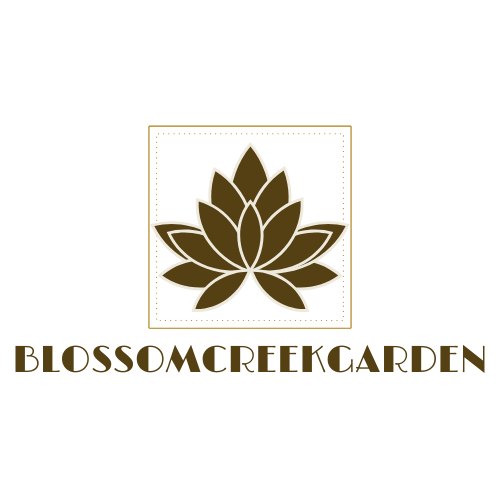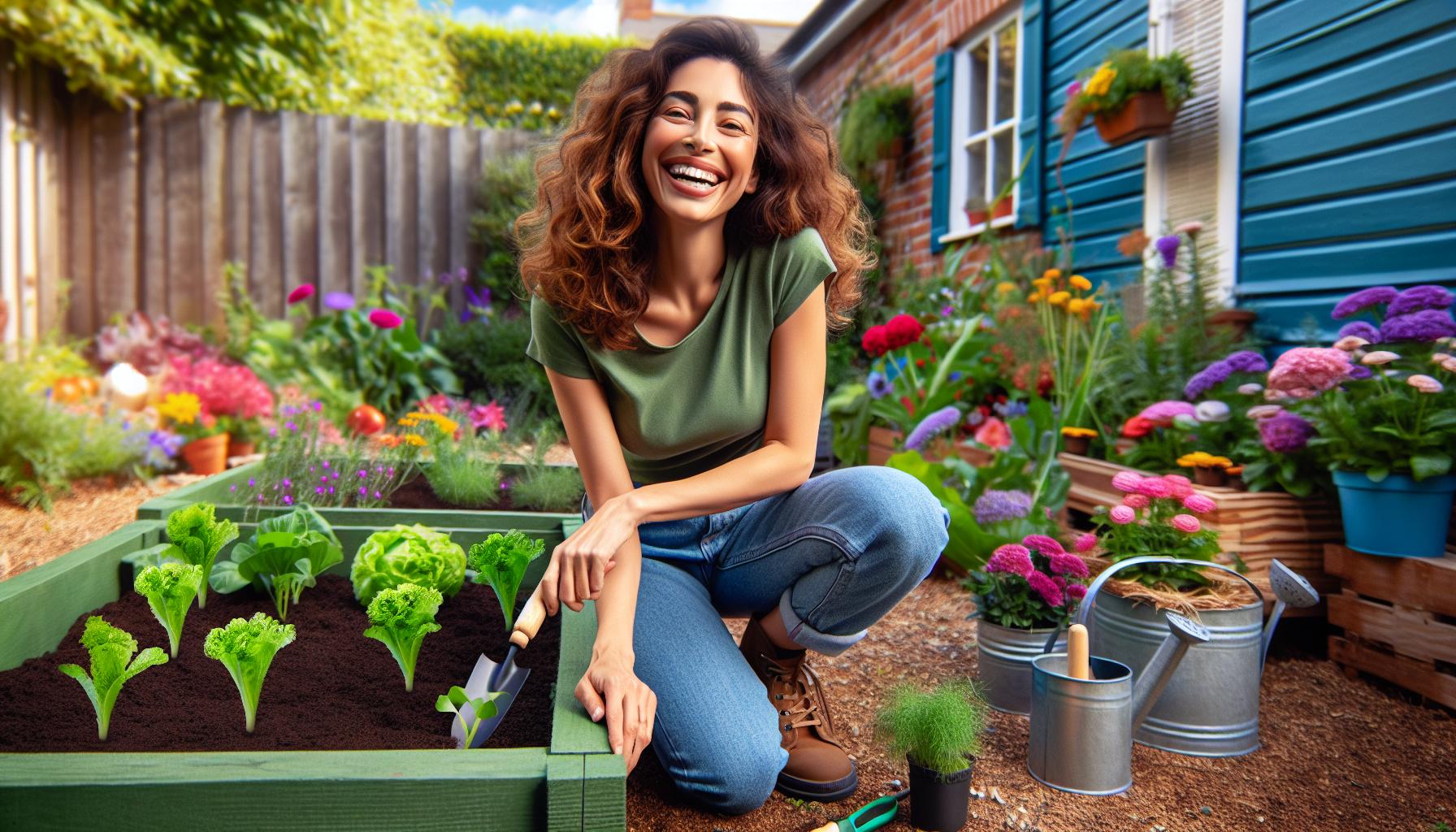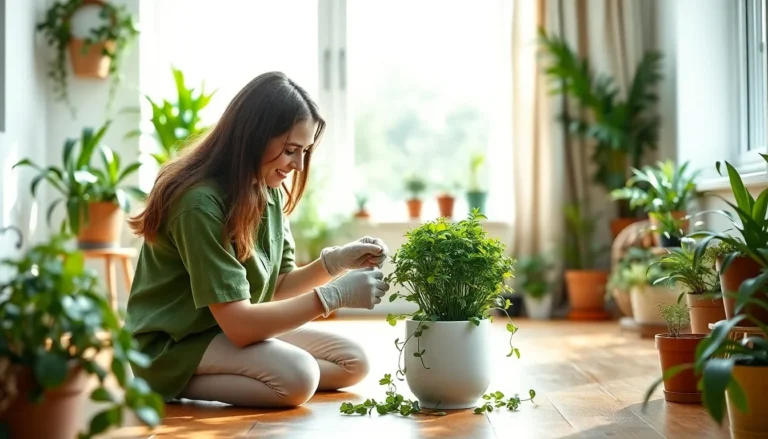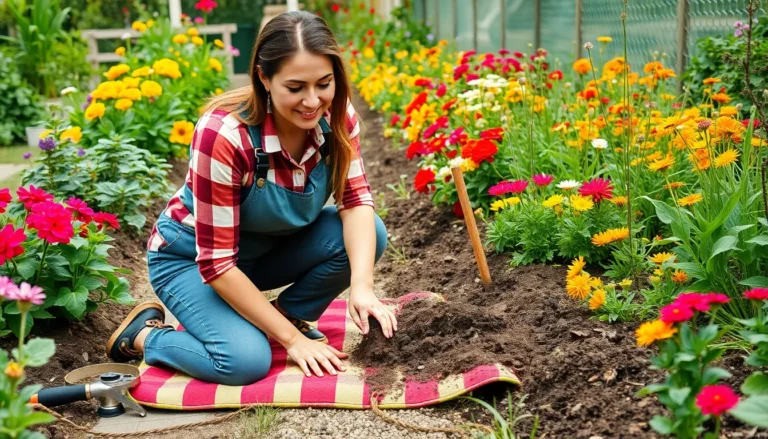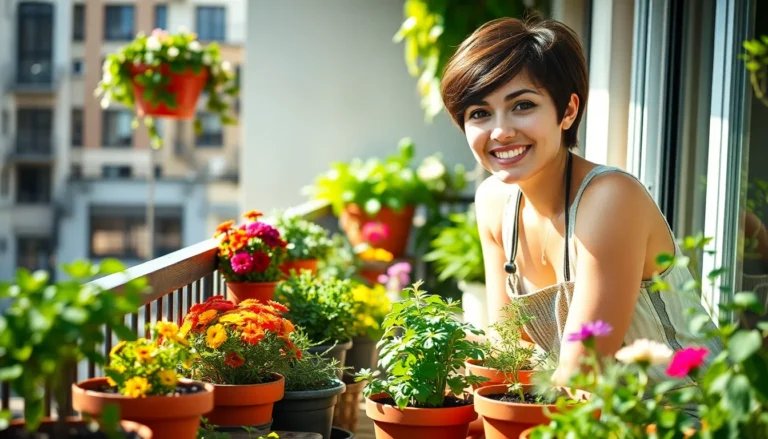Starting a garden can feel overwhelming but I’ve discovered that choosing the right plants makes all the difference. As a beginner gardener I learned that some plants are more forgiving than others and will flourish even without a green thumb.
Over my years of gardening experience I’ve identified several fail-proof plants that are perfect for novice gardeners. These resilient varieties don’t demand constant attention and can thrive in various conditions. Whether you’re working with a small balcony garden or a spacious backyard I’ll show you which plants will give you the confidence to develop your gardening skills while enjoying beautiful results.
Key Takeaways
- Select easy-to-grow plants like tomatoes, leafy greens, and marigolds for the best beginner gardening success
- Ensure proper watering by checking soil moisture and watering deeply but infrequently at soil level during morning hours
- Start with essential tools including hand trowel, pruning shears, watering can, and garden gloves for basic maintenance
- Maintain adequate spacing between plants and choose appropriate container sizes to prevent overcrowding and root restriction
- Monitor plants regularly for pests and diseases while avoiding common mistakes like overwatering and improper sunlight exposure
- Follow basic care guidelines for soil preparation, fertilizing, and sunlight requirements to help plants thrive
Benefits of Starting a Garden as a Beginner
Starting a garden transformed my daily routine in meaningful ways. I’ve experienced firsthand how gardening offers tangible benefits for novice plant enthusiasts.
Physical Benefits
- Burn 150-300 calories per hour through digging planting pots moving soil
- Build upper body strength from carrying watering cans mulch bags gardening tools
- Improve flexibility through regular bending reaching pruning activities
- Increase vitamin D levels with 30 minutes of outdoor gardening time
Mental Health Advantages
- Reduce stress levels through focused plant care activities
- Boost mood with visible growth progress tracking
- Develop mindfulness by observing plant development stages
- Create a sense of accomplishment from nurturing plants to maturity
Environmental Impact
- Decrease grocery packaging waste by growing fresh herbs vegetables
- Lower carbon footprint through local food production
- Support local pollinators with flowering plants like marigolds zinnias
- Improve air quality with oxygen-producing indoor plants
Economic Value
| Cost Savings Area | Annual Savings Potential |
|---|---|
| Fresh Herbs | $100-200 |
| Vegetables | $300-600 |
| Flowering Plants | $150-300 |
| Seedling Production | $75-150 |
- Master basic plant science through hands-on experience
- Develop problem-solving skills managing plant health issues
- Learn seasonal planning for continuous harvests
- Gain expertise in organic growing methods
These benefits emerge gradually as gardening skills develop creating a rewarding journey from novice to experienced gardener.
Essential Tools and Supplies for New Gardeners
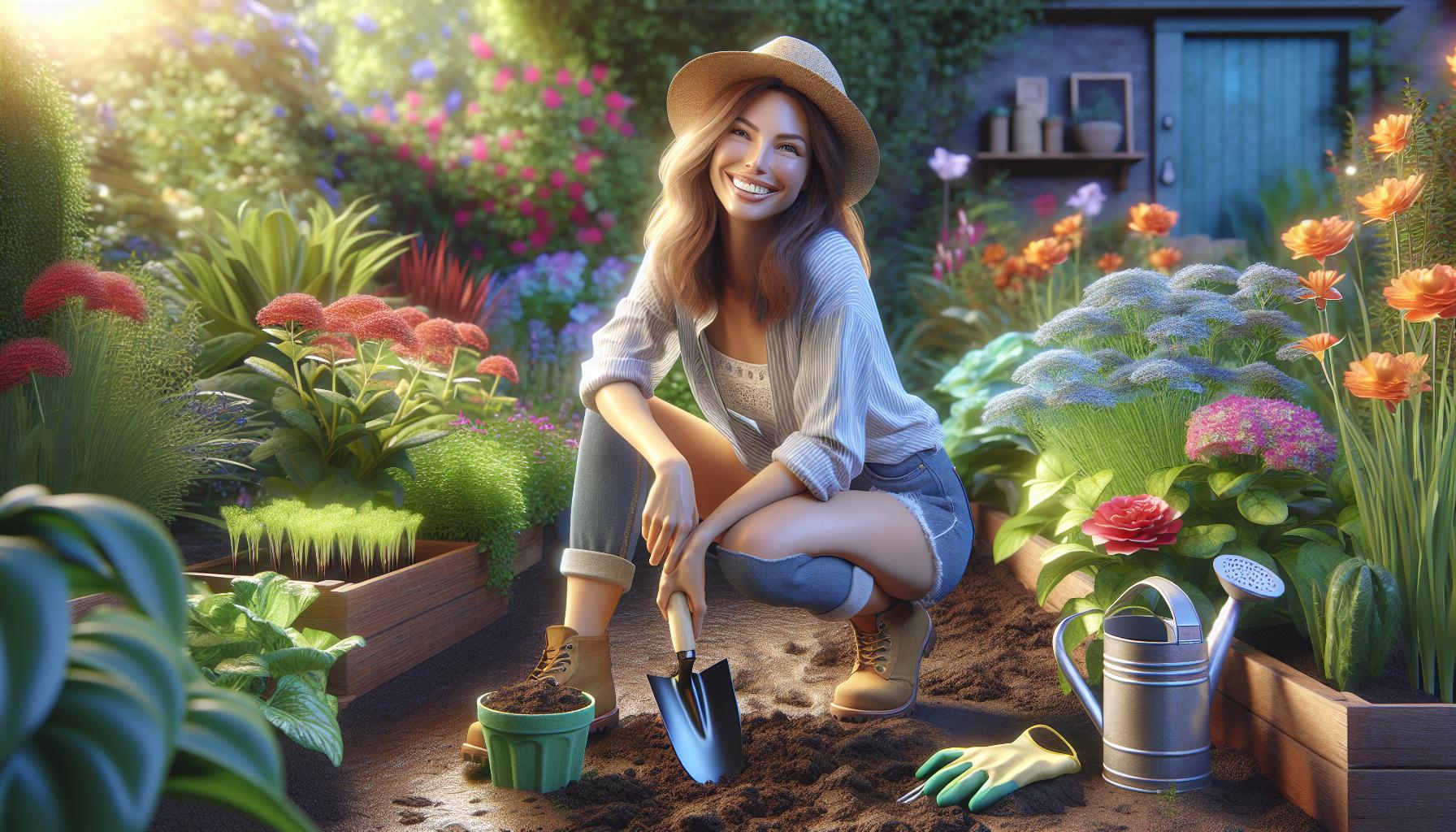
Basic Hand Tools
I’ve found these fundamental gardening tools indispensable for daily tasks:
- Hand trowel for digging planting holes transplanting seedlings
- Hand pruners for trimming stems cutting back plants harvesting
- Garden fork for loosening soil breaking up clumps aerating
- Hand cultivator for weeding mixing soil amendments spreading mulch
- Watering can with rain-style head for gentle plant watering
Soil and Amendments
Here’s what I use to create optimal growing conditions:
- Potting mix for container plants
- Garden soil for in-ground planting
- Organic compost for nutrient enrichment
- Mulch for moisture retention weed prevention
- pH testing kit for soil analysis
Plant Protection
These items help safeguard plants from environmental stress:
- Plant markers for identifying different species
- Garden twine for supporting climbing plants
- Row covers for frost temperature control
- Garden stakes for tall plant support
- Plant cages for tomatoes peppers vine crops
Container Options
I recommend these containers for versatile growing spaces:
- 12-inch plastic pots for herbs single plants
- 18-inch ceramic containers for multiple plants
- Self-watering planters for moisture consistency
- Fabric grow bags for root crops vegetables
- Window boxes for compact herb gardens
- Bypass pruning shears for clean stem cuts
- Garden gloves for hand protection
- 5-gallon bucket for tool storage debris collection
- Wheelbarrow for moving soil mulch plants
- Garden hose with adjustable nozzle for efficient watering
| Essential Tool | Average Cost | Lifespan (Years) |
|---|---|---|
| Hand Trowel | $10-15 | 5-7 |
| Pruning Shears | $20-30 | 3-5 |
| Garden Fork | $15-25 | 7-10 |
| Watering Can | $15-20 | 4-6 |
| Basic Gloves | $8-12 | 1-2 |
Best Vegetables for Beginner Gardeners
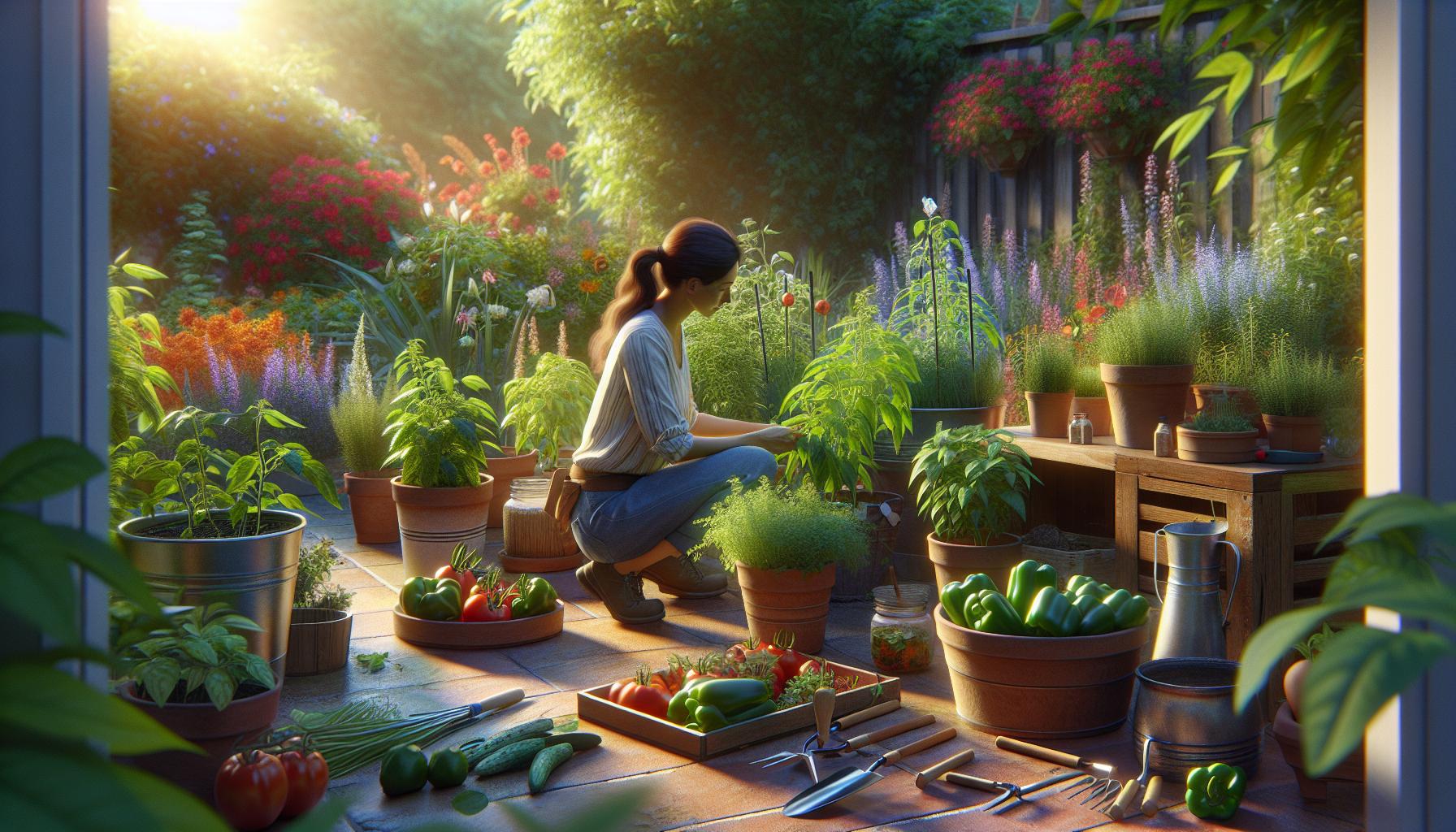
Growing vegetables offers an ideal entry point into gardening with quick, rewarding results. I’ve identified three groups of vegetables that consistently produce successful harvests for novice gardeners.
Tomatoes and Bell Peppers
Tomatoes and bell peppers thrive in containers with 6-8 hours of direct sunlight. I plant cherry tomato varieties like ‘Sweet 100’ or ‘Sungold’ in 5-gallon containers with support stakes. Bell peppers produce abundant harvests in 3-gallon pots, particularly varieties like ‘California Wonder’ or ‘Sweet Banana’. These plants require:
- Regular watering to maintain moist soil
- Monthly feeding with balanced fertilizer
- Pruning of yellowed leaves
- Vertical support systems for steady growth
Leafy Greens and Herbs
Leafy greens grow quickly in partial shade conditions with minimal maintenance. I’ve had success with:
- Lettuce varieties: ‘Black Seeded Simpson’ ‘Buttercrunch’
- Spinach types: ‘Space’ ‘Bloomsdale’
- Common herbs: Basil Mint Oregano
- Asian greens: Bok choy Mizuna
These plants mature in 30-45 days produce multiple harvests through cut-and-come-again methods.
- Radishes: Ready in 20-30 days
- Carrots: ‘Nantes’ or ‘Danvers Half Long’ varieties
- Beets: ‘Detroit Dark Red’ or ‘Chioggia’
- Turnips: ‘Tokyo Cross’ or ‘Purple Top’
| Root Vegetable | Days to Harvest | Container Depth |
|---|---|---|
| Radishes | 20-30 days | 6 inches |
| Carrots | 70-80 days | 12 inches |
| Beets | 50-60 days | 8 inches |
| Turnips | 40-50 days | 8 inches |
Easy-to-Grow Flowers for Beginners
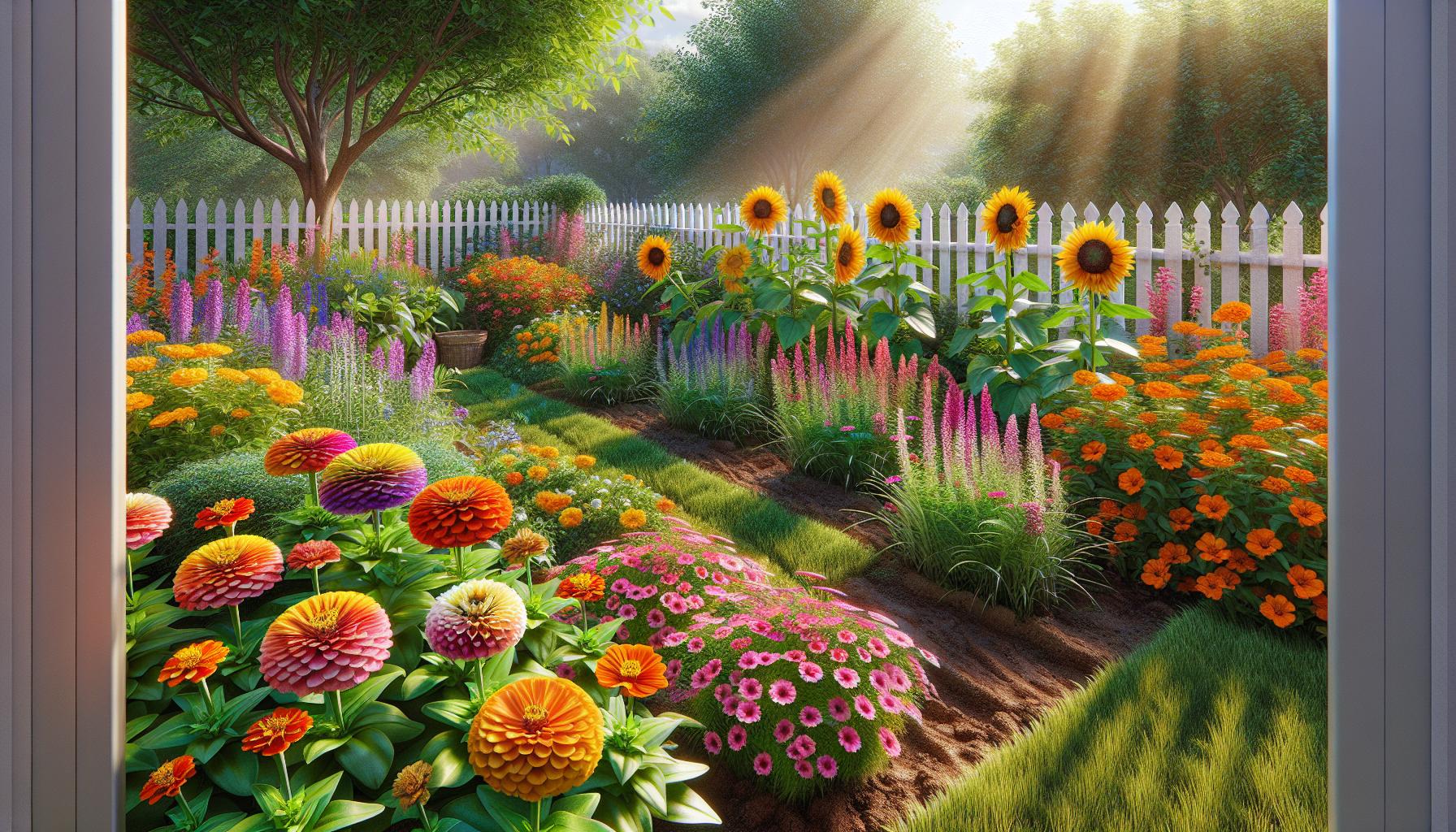
Growing flowers adds vibrant colors to any garden space while attracting beneficial pollinators. I’ve found these flowering plants thrive with minimal care, making them perfect for novice gardeners.
Marigolds and Zinnias
Marigolds produce abundant blooms in orange yellow or red from spring through fall with 6-8 hours of direct sunlight. I plant French marigolds 6-8 inches apart in well-draining soil enriched with compost. Zinnias grow quickly from seeds planted directly in the garden after the last frost, reaching heights of 6-36 inches depending on variety. These drought-tolerant flowers bloom continuously when deadheaded regularly, providing fresh cut flowers all season.
| Flower Type | Bloom Time | Height | Spacing | Sun Requirements |
|---|---|---|---|---|
| Marigolds | 8 weeks | 6-12″ | 6-8″ | Full sun |
| Zinnias | 8-10 weeks | 6-36″ | 6-12″ | Full sun |
Sunflowers and Cosmos
Sunflowers germinate easily when sown 1 inch deep directly into nutrient-rich soil after frost danger passes. I grow dwarf varieties reaching 2-3 feet for containers or classic giants stretching 6-8 feet tall along fences. Cosmos thrive in poor soil with minimal water, producing pink white or purple blooms on 3-6 foot stems. These self-seeding annuals flower prolifically from early summer until first frost with occasional deadheading.
| Flower Type | Bloom Time | Height | Spacing | Sun Requirements |
|---|---|---|---|---|
| Sunflowers | 10-12 weeks | 2-8′ | 6″ | Full sun |
| Cosmos | 7-8 weeks | 3-6′ | 12-18″ | Full sun |
Basic Plant Care Tips for Success
I’ve learned through experience that successful gardening relies on understanding fundamental plant care principles. These essential techniques ensure plants thrive regardless of your gardening space or skill level.
Proper Watering Techniques
Water penetrates soil at different rates based on its composition. I water deeply but infrequently, allowing the top 1-2 inches of soil to dry between sessions. Here’s my proven watering approach:
- Water at soil level to prevent leaf diseases
- Apply water in the morning between 6-10 AM
- Use mulch to retain moisture (2-3 inches deep)
- Check soil moisture with a finger test
- Adjust frequency based on weather (less in rain more in heat)
| Plant Type | Watering Frequency | Water Amount |
|---|---|---|
| Vegetables | 2-3 times weekly | 1-1.5 inches |
| Flowers | 1-2 times weekly | 1 inch |
| Herbs | 1-2 times weekly | 0.5-1 inch |
- Full sun: 6+ hours direct sunlight (tomatoes zinnias sunflowers)
- Partial sun: 4-6 hours direct sunlight (peppers marigolds lettuce)
- Partial shade: 2-4 hours direct sunlight (herbs leafy greens)
- Full shade: Less than 2 hours direct sunlight (ferns hostas)
| Light Condition | Morning Sun | Afternoon Sun | Plant Examples |
|---|---|---|---|
| Full Sun | Yes | Yes | Tomatoes Zinnias |
| Partial Sun | Yes | No | Lettuce Peppers |
| Partial Shade | No | Yes | Herbs Coleus |
| Full Shade | No | No | Ferns Hostas |
Common Mistakes to Avoid
Overwatering Plants
I’ve seen novice gardeners drown their plants with daily watering. Most plants need water only when the top 1-2 inches of soil feels dry to the touch. Signs of overwatering include yellowing leaves, root rot, fungal growth in soil.
Ignoring Sunlight Requirements
Placing sun-loving plants in shade or shade-loving plants in direct sun leads to poor growth. For example, tomatoes require 6-8 hours of direct sunlight while lettuce thrives in partial shade with 3-4 hours of sun.
Overcrowding Plants
Planting too close together restricts airflow increases disease risk. Space requirements:
- Small herbs: 6-12 inches apart
- Medium vegetables: 12-18 inches apart
- Large plants: 24-36 inches apart
Improper Soil Preparation
Starting with poor soil limits plant growth. Essential soil amendments include:
- Organic compost: 2-3 inches mixed into top layer
- Peat moss: 1 inch for moisture retention
- Vermiculite: 1 cup per square foot for drainage
Neglecting to Monitor for Pests
Early pest detection prevents widespread damage. Check plants twice weekly for:
- Holes in leaves
- Discolored spots
- Webbing
- Insect eggs underneath leaves
Using Wrong Container Sizes
Small containers restrict root growth. Minimum pot sizes:
| Plant Type | Container Depth | Container Width |
|---|---|---|
| Herbs | 6 inches | 6 inches |
| Leafy Greens | 8 inches | 12 inches |
| Tomatoes | 12 inches | 18 inches |
Fertilizing Incorrectly
Over-fertilizing burns plants while under-fertilizing stunts growth. Apply balanced fertilizer (10-10-10) monthly during growing season at half strength for container plants.
Conclusion
Starting a garden doesn’t have to be overwhelming. I’ve found that choosing beginner-friendly plants paired with the right tools and basic knowledge creates a solid foundation for success. The plants I’ve recommended are tried and tested champions that’ll help build your confidence as you develop your green thumb.
Remember that every gardener started as a beginner and there’s no shame in starting small. The physical mental and economic benefits of gardening make it worth pushing through any initial challenges. I’m confident that with these plant suggestions and care tips you’ll be well on your way to creating your own thriving garden space.
Ready to get your hands dirty? Your gardening journey starts now!
